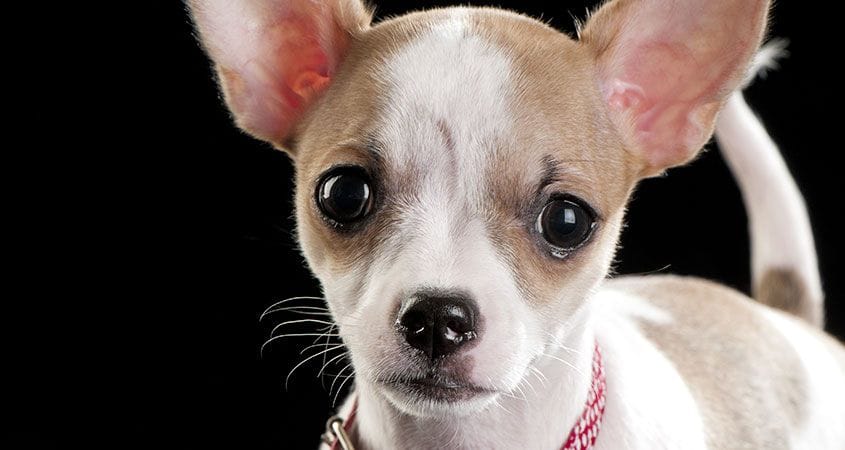Lissa (my long-haired Chihuahua mix) had watery eyes all the time.
So, I understand why a lot of people wonder…
Why do Chihuahuas cry?

In this article, you’ll discover…
- What types of allergies can lead to dog tears.
- 3 eyelash disorders and how to recognize them.
- The relation between (un)filtered water and dog tears.
- And more…
Why do Chihuahuas cry?
The reasons why Chihuahuas cry tears vary. They could range from genetic predisposition to external factors. For some Chihuahuas shedding tears is normal. For others though, it could be an indication of an underlying health issue, especially if it has begun suddenly.
It’s important to determine the cause of tear stains timely in order to prevent any possible threats to your Chihuahua’s health.
To do that, you should first learn more about each possible cause.
15 reasons why Chihuahuas have watery eyes
#1: Puppy teething
Puppy teething is a period during which you can notice excessive tearing.
This is nothing to worry about. To be extra sure, consult with your vet if you notice anything like that during the teething period.
#2: Allergies

Is your Chihuahua allergic to something?
Allergies can be environmental, seasonal, and food-related.
Let’s take dust (environmental) and pollen (seasonal) for example. Usually, they aren’t harmful to your Chi.
The Chihuahua’s immune system serves as protection from infection and disease. But when it comes in touch with allergens, it can harm the body.
As soon as the immune system comes in contact with an allergen it detects as a danger, it starts producing histamines. These are what cause inflammation leading to itching and swelling.
What causes allergies?
Here’s a list of allergens your Chihuahua could have a reaction to:
- Mold.
- Fungi.
- Grass.
- Pollen.
- Weeds.
- Flea saliva.
Although not listed here, your Chi could have a strong reaction to a certain type of food.
How to tell if your Chihuahua has a seasonal allergy or a food allergy?
If your Chihuahua is a victim of seasonal allergies, you’d see the symptoms around spring and fall.
When you buy new food for your Chi and you notice something is off, check the ingredients. If it’s the same food, it could be that the manufacturer has changed some of the ingredients.
Your Chihuahua can experience food allergy at around any time of the year.
It could happen suddenly if the ingredient they have an intolerance for hasn’t been introduced to them before.
Caution: The safest and most accurate way to identify what type of allergy your Chihuahua might be suffering from, is to schedule a vet appointment. Be observant and tell your vet what reactions you’ve noticed and around what time.
#3: Airborne irritants
Second-hand smoke, dust, and perfumes could all irritate your Chihuahua’s eyes. If you have any doubt that one of these could be the reasons, simply stop exposing our Chihuahua to these irritants.
#4: Eyelash disorders
These will brush against your Chihuahua’s eye and cause irritation.
There are 3 types of ingrown eyelashes conditions. These are:
- Distichiasis. This is a condition caused by extra eyelashes. This is not to be confused with entropion. If a dog has entropion, there is a normal amount of eyelashes but because the eyelid is inverted they cause irritation to the eye.
- Trichiasis. This happens when hair is growing towards the eyes instead of forward and up.
- Ectopic cilia. Thisis a condition that causes the lashes to grow through the inside of the eyelid. It can be hard to tell your dogs’ eyes are irritated because of this condition as it might look like a general eye irritation.
How to recognize these?
Symptoms include:
- Pawing at the eyes.
- Corneal ulcers.
- Inflammation.
- Eye discharge.
- Excessive tearing.
- Eyelid twitching or tweaking.
#5: Small and shallow eye sockets
In order for a Chihuahua to have normal tear drain, the eye sockets should be big and deep enough. If that’s not the case, the tears will end up on the side of the eyes.
#6: Eye infections
Eye infections occur due to parasites, bacteria, and viruses. An eye infection can happen even if shampoo gets into your Chihuahua’s eye.
#7: Ear infections
What if one of your Chihuahua’s ears is infected? It will likely cause the production of tears in the eye that’s on the same side of the head.
#8: Blocked tear duct
If the tear ducts are blocked, the tears will have nowhere else to drain except for around your Chihuahua’s eyes.
How to recognize it?
- Red eyes.
- Puffy eyes.
- Excessive tearing.
- Pawing at the eyes.
- Wetness around the eyes.
- Reddish-colored tear stains below the eye.
Causes of blocked tear ducts in Chihuahuas
- An eye injury.
- Cornea ulcers.
- Tear duct infection.
- Breed/genetic predisposition.
The tear ducts can get infected by either dust or a parasite that gets inside.
If your Chihuahua as had their eye injured, it could smell and block the tear duct.
The case could be that your Chihuahua is born with narrower tear ducts. This leads to blockages.
#9: Conjunctivitis
Conjunctivitis is easy to recognize due to the strong inflammation it causes to the eyes. If your Chihuahua has it, their eyes will become red and will also itch.
How does a Chihuahua get conjunctivitis?
Conjunctivitis could occur due to a respiratory tract infection. Or, it could happen due to some kind of eye irritation.
Causes could be:
- Dry eye.
- Entropion.
- Eye trauma.
- Systemic illness.
- Airborne irritants (see reason #2).
How to recognize it?
It’s characterized by:
- Bloody eyes.
- Eye discharge.
- Swollen eyelids.
- Rubbing the eyes against the floor, furniture, or pawing at them.
Sinus infections are common amongst dogs, as they are amongst humans.
#10: Sinus infections
Your Chihuahua’s sinuses could get inflammation by bacteria, viruses, or due to certain allergens.
How to recognize it?
Be on the lookout for:
- Snoring.
- Fatigue.
- Sneezing.
- Eye discharge.
- Loss of appetite.
- Decreased airflow.
- Breathing through the mouth.

Glaucoma is a medical condition that causes a build-up of fluid and eye pressure which can eventually lead to blindness.
How to recognize it?
Symptoms include:
- Eye pain.
- Teary eye.
- Eye redness.
- Cloudy cornea.
- Seeing difficulties.
- Intolerance of light.
- Swelling of the eye.
- Differently-sized pupils.
How does a Chihuahua get glaucoma?
There are two types of glaucoma – primary and secondary.
Primary glaucoma is genetically inherited. When there’s a lot of fluid production in the eye or it doesn’t drain properly, it increases the eye pressure.
Primary glaucoma can be diagnosed during when the dog is between 3 to 7 years old.
Secondary glaucoma has to do with an underlying disease. Secondary glaucoma is more commonly seen than primary glaucoma. It can be triggered during the dog’s mid-life.
Triggers include:
- Tumors.
- Eye cancer.
- Inflammation.
- Eye Infections.
- Retinal detachment.
- Advanced cataracts
Regardless of which type of glaucoma your Chihuahua has, it leads to the inability to drain fluid properly.
#12: Entropion (inverted eyelid)
An inverted eyelid can cause discomfort to the eye. Eyelashes, hair, and debris can easily touch and irritate the eye. This could also be painful for your Chihuahua.
Your Chihuahua could be predisposed to it as they are part of the brachycephalic dog group. This means that dogs with short heads and noses are more likely to get it.
One way to know if the entropion your Chihuahua gets is inherited is if it occurs before the Chihuahua has turned one year old.
Cases of mild entropion cause nothing more than mere discomfort and inconvenience.
A Chihuahua could have entropion either due to genetics or because they’ve experienced some kind of eye trauma (scratched cornea, an eye infection like conjunctivitis).
Caution: If entropion is not treated, it can lead to eye ulcers and even loss of vision.
How to recognize it?
You can recognize your Chihuahua has entropion if they show any of these symptoms:
- Eye squinting.
- Sensitivity to light.
- Inner eye inflammation.
- Excessive eye discharge.
- Sagged skin around the eye socket.
Monitor your Chuihuahua’s eyes and be on the lookout for mucus-like discharge.
Having entropion can also cause your Chihuahua to paw its eyes. This is likely to happen more when you take your Chi outside.
Caution: If you notice any of the above-listed symptoms, do not wait and take your dog to the vet. They’ll determine how intense the entropion is and select an appropriate treatment.
#13: Unfiltered water
Have you given your Chihuahua to drink from your bottle while out on a walk?
If so and they’ve started having tear stains soon after, it’s advisable to be careful what type of water you’re giving to your dog.
Better revert to filtered or distilled water.
#14: Plastic food bowl
Plastic food bowls that have been used for some time already can easily contain bacteria which could irritate your Chihuahua’s eyes.
#15: Diet

Last but not least comes the diet of your Chihuahua.
They could have some type of food intolerance. To check if that is the case, you could switch foods.
Tip: Ask your vet for recommendations on food based on your individual Chihuahua’s health. Make the food switch gradually as a sudden change might lead to diarrhea.




